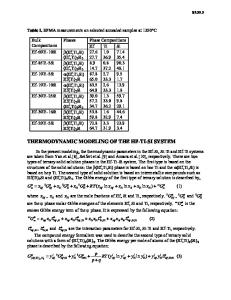Evaluation of the thermodynamic properties and phase equilibria of the Re-Ta-W system
- PDF / 232,285 Bytes
- 7 Pages / 612 x 792 pts (letter) Page_size
- 11 Downloads / 352 Views
HE ternary Re-Ta-W system is composed of the three metals with the highest melting temperatures. They have been used either in combination with one another, such as tungsten-rhenium alloys,[1] or as alloying elements in materials, such as Ni-based superalloys.[2] A thermodynamic understanding of alloying effects is critical in providing quantitative guidelines for alloy development and processing design. The present work contributes to the development of a thermodynamic description of the ternary system by means of the calculation of phase diagram (CALPHAD) approach.[3] In this approach, the Gibbs energies of all the phases in a system are modeled as a function of temperature and compositions and are developed based on existing thermodynamic and phase equilibrium data. In the CALPHAD approach, the thermodynamic description of a multicomponent system is built up from the unary, binary, and other lower-order systems. The thermodynamic descriptions of pure Re, Ta, and W are taken from the Scientific Group Thermodata Europe (SGTE) pure element database compiled by Dinsdale.[4] The thermodynamic descriptions of the Re-Ta and Re-W systems are recently developed by Liu and Chang,[5] and the calculated phase diagrams are reproduced in Figures 1 and 2. The thermodynamic description of the binary Ta-W system evaluated by Huang and Guillermet[6] and Kaufman et al.[7] are given in Table I. The recent assessment by Kaufman et al.[7] was received after completion of the present work. The parameters evaluated by Huang and Guillermet[6] were used in present work. There are five phases in the ternary system, i.e., liquid, bcc, hexagonal closed pack (hcp), , and phases. The thermodynamic modeling of intermetallic compounds and phases are described with three sublattice models. The ternary parameters ⌬GRe:Ta:W and ⌬GRe:W:Ta of the and phases are evaluated from the binary parameters ⌬GRe:Ta:Ta and ⌬GRe:W:W by assuming a linear relation
between binary and ternary parameters. The ternary-interaction parameters of the , , liquid, and bcc phases are optimized using available experimental data in the literature. II. EXPERIMENTAL INFORMATION The experimental measurements on the Re-Ta-W ternary system were from two research groups. Brophy et al.[8] examined 100 alloys with different compositions after heat treatment at 2953, 2803, 2293, and 1473 K for 1, 2, 4, and 168 hours, respectively, by X-ray diffraction, metallographic phase identification, X-ray fluorescent, and wet-chemical analyses. Solidus temperatures were measured by the detection of incipient melting in 18 alloys. Their results were presented in both figures and a table. Tregubov et al. studied three diffusion couples of pure Re and three Ta-W binary alloys at 2773[9] and 1773 K,[10] respectively. Their results are in qualitative agreement with the data by Brophy et al.[8] There are no thermochemical measurements available for the Re-Ta-W ternary system in the literature. III. THERMODYNAMIC MODELS There are two types of phases in the system, i.e., solution phases and
Data Loading...











